![]()
![]()
©
1999 The Independent Fact Group
Forgery to hide lack of seaworthiness
(An excerpt from the full report)
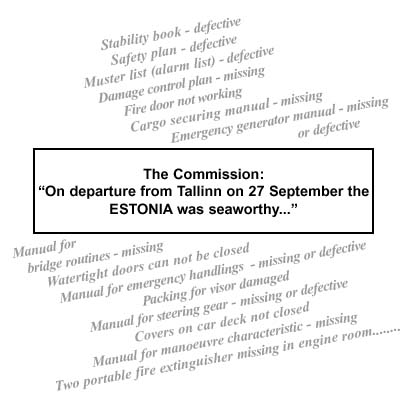
STATEMENT REPORT
| Subject: | Forgery to hide lack of seaworthiness |
| Type: | Statement |
| By: | Björn Stenberg and Johan Ridderstolpe |
| Status: | Proved |
| Date: | 99-10-20 |
| Version: | Report excerpt - English translation |
The Fact Group's aims and objectives:
The Independent Fact Group was formed in early 1999 to clear up the many question marks about the MS Estonia disaster, in a structured and methodical manner. There has been considerable speculation concerning the efforts of the Joint Accident Investigation Commission (JAIC) and the political, legal and media treatment of the accident and its tragic consequences.
The aim is to give those in authority an opportunity, based on the facts of the case, to decide to review this matter, with a view to further action. Our efforts also enable the media and the general public to decide on the basis of the objective information which is available concerning the accident, and the conclusions to be drawn from a technical and civic perspective.
The overall objective is the setting up of a new investigation of the accident which can describe the course of the accident in detail, and its causes, with subsequent assessment of the moral and legal responsibilities, where this is feasible.
We are motivated by the belief that a properly conducted investigation will contribute to maritime safety and by our concern for Sweden's reputation as a nation which upholds safety at sea and the rule of law.
Methodology:
In the course of this task, we have assumed that the solution of a problem is never better than the validity of the basic assumptions. As a result, we have stipulated some methodological principles, of which the following are the most fundamental:
1.All scenarios must be considered to be true until the contrary
is proved.
2.All observations, assumptions or statements on which a scenario
is based must be considered false until the contrary is proved.
We have defined a number of criteria for concluding that an observation, assumption or statement may be considered to be true or false, and processes and routines for the route to be taken in clarifying an observation, assumption or statement. These criteria involve technical, empirical, statistical and/or semantic requirements which, if they are relevant must all be met if the observation, assumption or statement is to be classified as an objective fact.
The materials we have worked with are primarily the documents, audio recordings and films in the Swedish Accident Investigation Commission's Estonia archive, together with supplementary information from other public sources and, in addition documentation from the Meyer shipyard and its independent commission.
| Table of Contents * |
Page |
| Summary |
3 |
| Definitions and explanations |
4 |
| International conventions (see also page 60 65) |
5 |
| National maritime administrations and classification societies |
6 |
| Cooperation in maritime projects, Sweden/Estonia |
7 |
| The Joint Accident Investigation Commission (JAIC) |
9 |
| Forgery of the Port State Control protocol |
10 |
| Final Port State Control in Tallinn |
17 |
| Deficiency 1: Bow door,
packing damage Deficiency 2: Sounding pipe, Aux Eng room Deficiency 3: 2 portable fire exting missing eng room Deficiency 4: Safety Plan Deficiency 5: Muster List Deficiency 6: Damage Control Plan Deficiency 7: Cargo operational manual Deficiency 8: Fire prevention Deficiency 9: "off-course" alarm not installed Deficiency 10: Means of control, MIMIC panel Deficiency 11: Manuals and instructions Deficiency 12: Windows in Galley not possible to close Deficiency 13: Covers on bulkhead deck to be closed Deficiency 14: Cargo securing devices |
18 |
| Interim certification after the transfer of nationality - Bureau Veritas |
56 |
| Some concluding questions |
58 |
| Analysis of SOLAS 74 (in relation to the inspection of MS Estonia on 27 September 1994) |
60 |
| Analysis of the Paris Memorandum
of Understanding (in relation to the inspection of MS Estonia on 27 September 1994) |
64 |
| Overview: MS Estonia 1992
- 1994 (chronological overview of certifications, inspections and exercises) |
66 |
| Sources |
67 |
| Dedication |
68 |
* Highlighted bold contents in this excerpt. Grayish content is yet to be translated. All contribution of funds is appreciated.
Summary (page 3)
In this report, the Independent Fact Group shows that the copy
of the Port State Control protocol printed in the JAIC's final
report is a forgery. The Port State Control was conducted on
27 September 1994 in Tallinn, that is to say on the afternoon
before MS Estonia left port for the last time. Although several
inspections (6 PSC's) of the Estonia had been carried out on
previous occasions in Stockholm without any major criticism,
a considerable number of deficiencies were discovered on this
occasion, 14 of which were noted in the report.
The Estonian National Maritime Investigation Board official headed the inspection team, and also signed the report which was produced. Eight Estonian shipping inspectors participated, and two Swedish inspectors. The Swedish participants were employed as "experts" who were training their Estonian colleagues in inspection methods in accordance with the Port State Control procedure. This training process took the form of seminars and specific inspections of vessels in international traffic. Under an agreement between the Estonian Ministry of Transport and Communications and the Swedish Maritime Administration, the Swedish inspectors were authorized to perform their inspection function with a direct mandate from the Estonian Ministry.
The Swedish Maritime Administration, the inspectors who participated, and the Accident Investigation Commission claim that this inspection was only for training purposes and that, as a result, it could not provide a basis for the measures required in accordance with the Law of the Sea.
The Independent Fact Group shows both that this was a proper inspection, and that the Law of the Sea does not cease to apply, irrespective of the circumstances in which deficiencies in the safety or functioning of a vessel are discovered. A more detailed analysis of the conventions and agreements signed by the Swedish and Estonian governments describes the duties and obligations which the governments had undertaken to carry out and comply with.
The report describes 14 deficiencies reported in relation to the Law of the Sea as it applied at that time, and the way in which they contributed to the course of the accident in certain cases, and to the very considerable number of passengers and crew who lost their lives. A number that would not have been so high if the Estonia had been seaworthy.
The only conclusion we can draw from the way in which the forgery was carried out is that it was done to marginalize the deficiencies on the Estonia, with the purpose of protecting the Swedish and Estonian maritime authorities from accusations of - at least - serious omissions in the exercise of their respective official duties. However, we delegate the task of defining appropriate charges to others. This also applies to indicating which authorities and individuals are legally responsible in this context.
Following careful analysis of the forgery, the documents concerned and statements made in police questioning, it is clear that the forger must have had access to the Swedish Accident Investigation Commission's Estonia archives. The Fact Group does not claim to be able to compete with a forensic laboratory, but normal eyesight is sufficient to enable an observer to confirm that the printed protocol is a forgery.
To summarize this report in a single sentence: Since the JAIC has committed criminal acts to hide the fact that the Estonia was not seaworthy, the current investigation must be declared invalid and, furthermore, the countries involved need to show that they are governed by the rule of law by insisting that those responsible for the crimes and offences reported in this context are held legally responsible.
Forgery of the Port State Control protocol (page 10 to 16)
Prior to MS Estonia's departure on 27 September 1994, Swedish Maritime Administration officials conducted a Port State Control of the vessel. This inspection took place during the afternoon in the Tallinn docks, and was reported in accordance with the relevant regulations. The Maritime Administration's representatives were Åke Sjöblom, Senior Inspector, and Gunnar Zahlér, Inspector. Aarne Valgma, head of the National Ship Inspection Division, was in charge of the Estonian inspection team.
The documentation submitted indicates that the Port State Control report consists of a "Form A" page and a "Form B" page in which the deficiencies discovered are noted. Form B is a set of forms containing an original page and two carbon copies.
Åke Sjöblom submitted the two original carbon copies of Form B of the Port State Control protocol to the Commission in Stockholm. These are recorded in the Estonia archive register on 3 November 1994 as documentary enclosure A 46 b and c. In the course of questioning by the police Sjöblom refused to hand over the documents, stating that they could only be submitted to the Commission. Åke Sjöblom and Gunnar Zahlér were also questioned by the Commission on 2 November 1994 (documentary enclosure D 6 a). In addition, a tape recording was made of an interview with Åke Sjöblom in Tallinn on 28 September 1994 (document D 28), and he was also questioned by telephone by the Swedish police (summarized version in the Swedish Accident Investigation Commission's Estonia archive, document D 8 (F242-1)).
A transcript of the questioning of Aarne Valgma by the Estonian police was submitted to the Commission indirectly, via the Estonian and Swedish police, on 4 January 1995, including a Port State Control protocol (attested copy of the first page of the set of forms B) (document D 9). The Commission has registered these documents as emanating from a survivor, since they were submitted together with a large number of transcripts from the questioning of survivors. It is interesting to note that Aarne Valgma was not even questioned by the Commission, despite the fact that he led and supervised the Port State Control, according to the police interview.
The JAIC's report on the condition of the ship on departure is as follows:
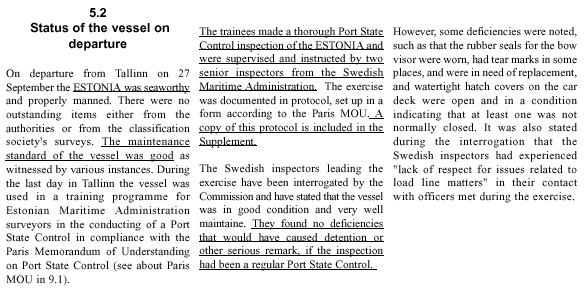
Illustration 1. JAIC final report 5.2
The above text indicates that MS Estonia was well maintained, that "a copy of this protocol is included in the Supplement", and that "They found no deficiencies that would have caused detention or other serious remark, if the inspection had been a regular Port State Control."
Evidence of forgery:
Supplement 223 contains the copy which the Commission claims is a copy of Sjöblom's "Form B". The printed copy (forgery) does not have the same contents as the two documents submitted to the Commission, and the signature is not authentic.
After detailed study of this document, we have found more than 20 obvious differences in comparison with the original. In this context, we will confine ourselves to describing six of these differences.
The various documents are presented at 70% of their original
scale in the following order:
1. The JAIC's forgery,
2. Åke Sjöblom's carbon copy original, submitted,
3. Aarne Valgma's attested copy of the first page of the protocol
Form B, submitted, and
4. the JAIC's forgery, with critical points circled to provide
a key. Subsequently there is an additional page with the various
signatures, in a 150% enlargement to permit more detailed comparison.
Fault 1: All references to the Swedish National Maritime Administration are missing on the forgery. On Valgma's copy, all references to the Maritime Administration are also missing, apart from the Administration's form designation. Sjöblom's carbon copy original indicates what the forgery should have looked like, had it been a copy.
Fault 2: The text in the third column (convention references) is missing from the forgery and from Valgma's copy. Sjöblom has completed these references correctly in accordance with the rules, indicating a detention of the vessel.
Fault 3: The forgery and Sjöblom's original both have additional handwritten text - "packing damage" and "A few pieces of sec. Dev worned out" - in column 2. Valgma's copy does not have these additions. It is interesting to note that that the additional text in the forgery does not have the same location in relation to the rest of the text as in Sjöblom's original. The forger must have had access to the Swedish archives.
Fault 4: Valgma's title on Valgma's copy and Sjöblom's original is "Head of National Ship Inspect. Division". The forger has filled in "Head of National Ship Inspection Department", which is not the correct title.
Fault 5: The printed text on the forgery is very weak and in some cases deleted, while the handwritten text is sharper than on Valgma's copy. Since the printed text has been edited out, all information concerning possible measures resulting from a Port State Control has disappeared.
Fault 6: The signatures and clarifications of names are forged. They are identical on Valgma's copy and Sjöblom's carbon copy original (even with a high degree of enlargement). Valgma's attestation, made two days later in connection with his questioning by the police, is virtually identical with his signature at the time of the Port State Control. It may also be noted that the text of the original is 11% "higher" and 1% "narrower" than in the forgery.
In the light of the faults which have been discovered, the only conclusion we can draw is that this forgery was carried out to marginalize the MS Estonia's defects, and also to protect the Swedish and the Estonian maritime authorities from allegations of deficiencies in their exercise of their respective official duties.
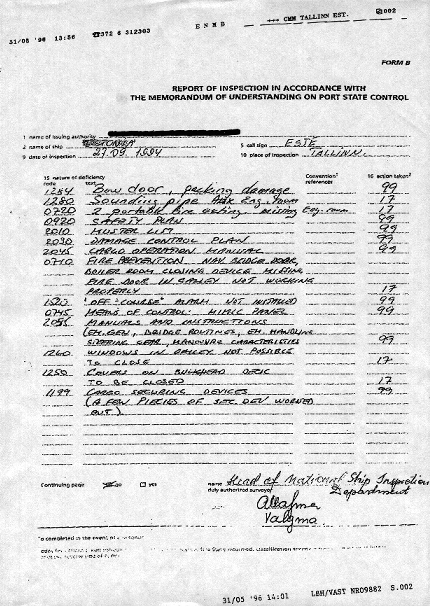
Illustration 2. The Joint Accident Investigation Commission's forgery (70%).
Note the signature, the lack of references to the Swedish National Maritime Administration, the poor quality of the printed text in the footnotes and the "fax signature". The fax signature gives the impression that the document was faxed at a skewed angle. The angle of the fax text indicates that, in this case, the paper would have been approximately 3 cm wider than if it had passed through the fax machine straight. We have been unable to find any fax machine which can cope with this. The telephone [fax] number currently has no subscriber.
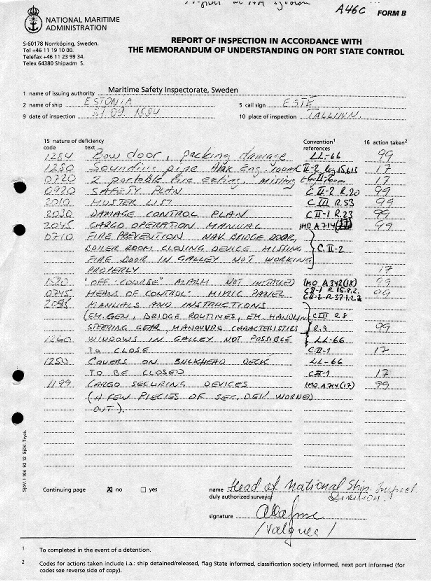
Illustration 3. Sjöblom's carbon copy original (70%)
Note the blurred carbon copy text in columns 1, 2 and 4 and the sharper text in column 3, which is written in ink at a later stage. The National Maritime Administration's English logo, typed name and form designation are all clearly reproduced.
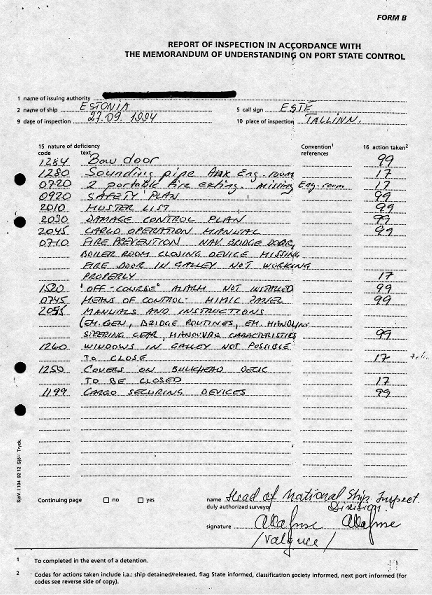
Illustration 4. Valgma's first page copy (70%).
Note that Valgma arranged the removal of the Swedish National Maritime Administration's logo but that the Administration's form code has not been deleted. The Maritime Administration's printed name has been painted over with a marker pen in this instance. The handwritten text is sharper than on Sjöblom's carbon copy and complies completely, in graphological terms. There are no notations on Valgma's copy, however. This also applies to the various crosses which appear on Sjöblom's carbon copy and on the Commission's forgery.
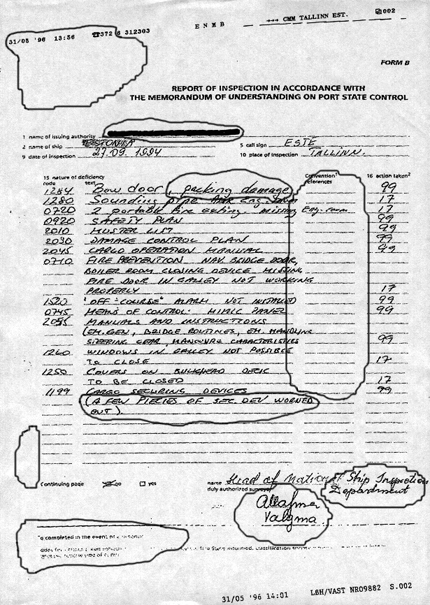
Illustration 5. The key (70%).
The circled areas represent clear differences compared with the reports submitted by Sjöblom and Valgma. Note, in particular, the signature and the completed text indicating the administrative unit head by Valgma. Since the footnote text has been obliterated, an uninitiated reader cannot see what measures a Port State Control might result in.
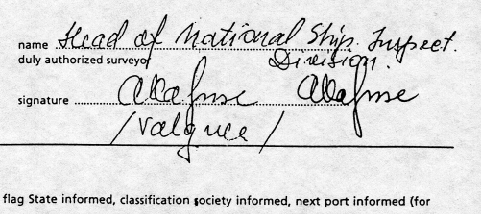
Illustration 6. Signatures: Valgma's attested first page copy (150%).
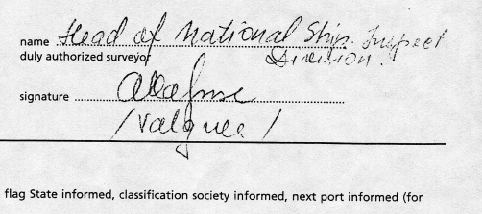
Illustration 7. Signature: Sjöblom's carbon copy original (150%).
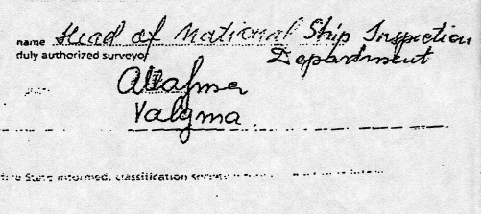
Illustration 8. Signature: The JAIC forgery (150%).
DEDICATION
We dedicate this report to all those who lost their lives at sea as a result of a ships lack of seaworthiness.
If MV Estonia had been seaworthy many of the more than 850 persons who lost their lives would have had a chance to survive.
Stockholm June 1999
For the Independent Fact Group
Björn Stenberg
Johan Ridderstolpe